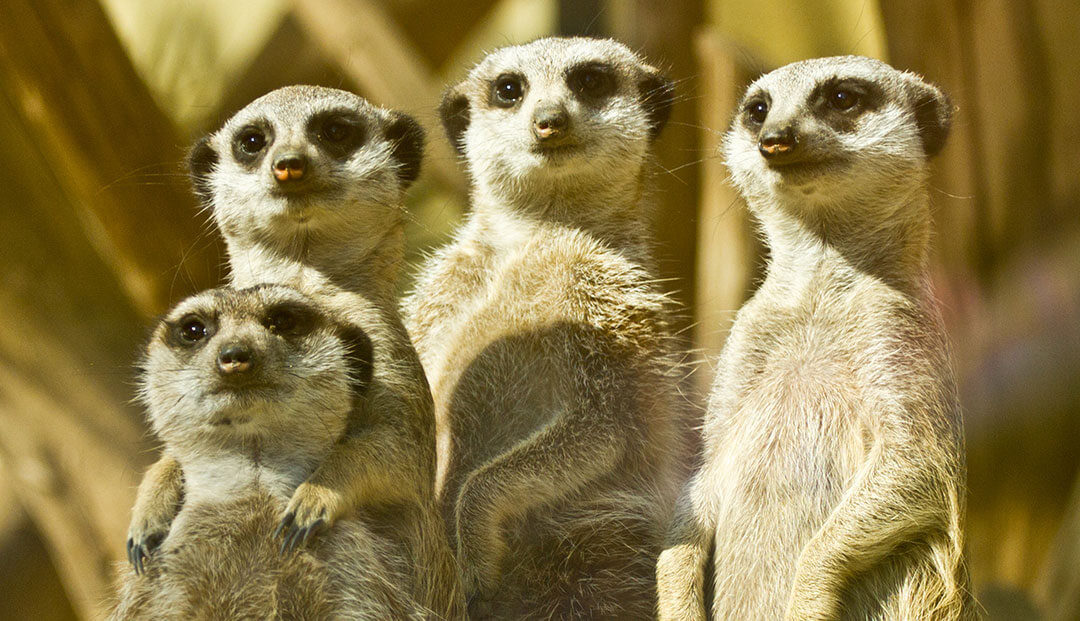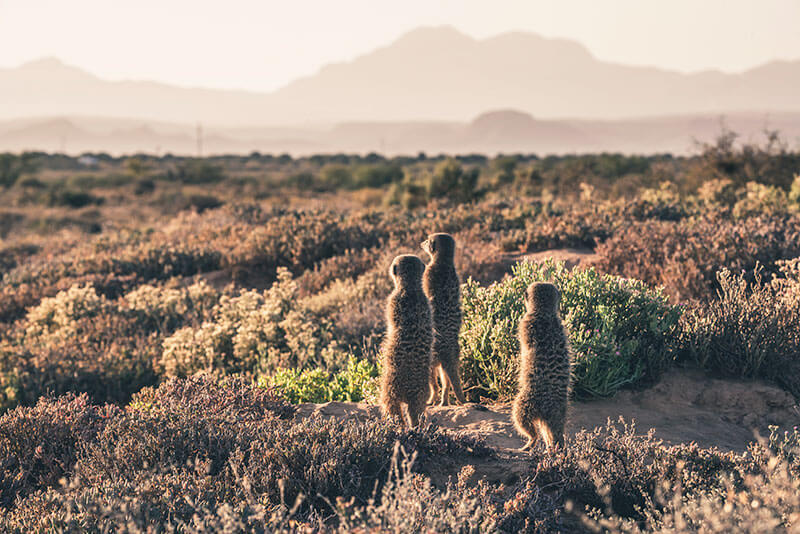Meerkats may be small, but don’t be misguided by their cuteness, these furry creatures are pretty hardcore when it comes to living in the wild.
Surviving in the harsh desert environment, meerkats have developed unique ways in which they can adapt and thrive in challenging conditions. Meerkats are one of those species that has always fascinated people with their unusual behaviours making them one of Africa’s most captivating small mammal species. To put it simply, they’re incredibly fascinating!
Read on to find out more about these incredible creatures.
What is a meerkat?
The meerkat (Suricata suricatta) is a small mammal belonging to the mongoose family. These furry creatures are covered in brown-striped, hair and have small, pointed faces with large eyes surrounded by dark patches.
Meerkats have a thin layer of fur covering a patch on their underbellies. The hair on their belly is thin enough to expose their skin and absorb the sun’s warm rays. After a chilly night in the burrow, meerkats come out and stand up to expose their bare bellies to the suns rays to warm themselves.
Social structure
Meerkats are incredibly social animals and live in groups called mobs, gangs or clans. These squirrel-sized creatures work incredibly well together. Mobs or gangs can have as little as three meerkats to as many as 50 members. Each member participates in gathering food, keeping a lookout for predators and babysitting the pups.
Hierarchy
Meerkat gangs are structured around a dominant couple who produce most of the offspring. The gang is made up of several family groups, but ultimately, the female of the alpha couple rules the burrow.
The alpha female is the only meerkat that is allowed to reproduce. If subordinate females from other family groups get pregnant, the dominant female will banish them from the den or even kill their pups.
Habitat
Meerkats live together in burrows, which they dig out with their sharp claws. Their eyes have a transparent membrane that shields them from the sand while digging and their ears are able to close when digging to prevent the sand from getting in.
The underground burrows can be up to 5 metres long and contain multiple entrances, tunnels and rooms. Depending on the size of the clan, a group can use up to five burrows at a time. Underground burrows keep members safe from threatening predators and out of the harsh desert heat.
Teamwork
Meerkats spend a lot of time grooming each other and playing together to keep the family a tight unit. They work together and hunt together in a collaborative effort, relying on a variety of distinct calls to communicate with each other.
Communication
One of the most vital roles a meerkat has in the group is a sentry, or watch guard. While the majority of the mob forages for food, one or more of the meerkats will find a vantage point and perch on its back legs while scanning the sky and the desert for potential threats.
If a sentry senses danger, it will let out a loud bark or a high-pitched squeal. The range of squeals indicates if the threat is of low or high urgency, and whether the threat is on the ground or in the air. The squeals will send the mob running for cover.
Meerkats are territorial
Meerkats dig safe places called bolt holes. These bolt holes throughout their territory are where they can hide if there is a threat. If caught in the open, a meerkat will defend itself by lying on its back and showing its teeth and claws. Team plaIf a group is confronted, the meerkats will stand together like a gang a viciously attack the predator.
Meerkats are known to kill venomous snakes, but they don’t work alone – they work as a gang. Meerkats are immune to scorpion venom and can withstand six times the snake venom it takes to kill a rabbit. If a snake is detected, the mob will gather to harass the snake, biting and clawing at it until it retreats or is killed.
Although meerkats are social and affectionate within their clan, they are also highly territorial and will engage in violent, territorial wars with neighbouring gangs. The fights are battled as a collective, with each gang posturing and attempting to intimidate the opposition first. If this fails, the fight will be brief but deadly.
What do meerkats eat?
Meerkats only go outside during daytime hours. Each morning, as the sun rises, the group emerges from their holes and begin looking for food. Meerkats are omnivores and use their keen sense of smell to locate their food, which includes eggs, fruit, plants, beetles, caterpillars, spiders and scorpions!
Meerkats are able to survive without consuming water, the animals get the moisture they need from eating roots.
The family protects the young
While most of the mob is foraging for food, back at the burrow, several babysitters stay behind to protect any newborn pups from rival mobs who will kill the babies if given a chance. This duty rotates to different male or female members of the mob, and a sitter will often go all day without food. But the other meerkats do reward their sitter with food at the end of the day.
Folklore
It is a widespread belief in the Zimbabwean and Zambian regions of Africa that the meerkat is a “sun angel.” It is said that they protect the villages, cattle, and lone tribesmen from danger. The name ‘sun angel’ likely applied to the meerkat due to their ‘glowing’ appearance in sunlight during their morning sun-basks.
Where are meerkats found
Meerkats can be found in the southern area of the African continent, including the Kalahari Desert, Botswana, Namibia, South Africa and in southwestern Angola.
Possibly one of the most adorable creatures to observe on your safari trip through Africa, meerkats can be found in one of the desert locations listed above. See these cute animals in their natural habitat, contact us to book your African safari trip now!
If you loved reading these interesting facts about meerkats, check out our collection of other interesting animal facts!
If you want to find out more about these adorable creatures, watch the YouTube web series Kalahari Meerkats now!



yo